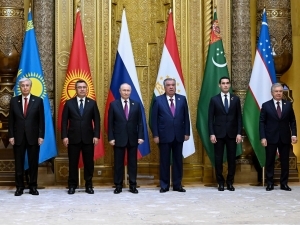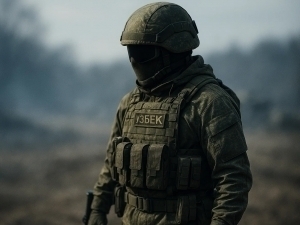Third day of the war, Iran's deadly strike, Israel crosses red lines, Zelensky loses spotlight, and India's aviation tragedy of the century – Weekend
Review
−
15 June 20655 12 minutes
Peace has vanished from the face of the earth. Wars are not stopping; on the contrary, they are increasing day by day. The number of conflicts worldwide has reached an all-time high, with military clashes growing year by year. The level of violence has significantly risen compared to the average of the last thirty years. The ongoing exchange of missiles and drones between Israel and Iran over the past three days threatens not only regional security but global stability. This confrontation differs significantly from Russia’s invasion of Ukraine or Israel’s operation in Gaza, as this time both sides are evenly matched. Clashes between equal powers are often remembered with great sorrow.
QALAMPIR.UZ presents the "Weekend" program with a detailed overview of major global events over the past week.
New war – new threat
The clash between Israel and Iran began on June 13. Of course, this was not a sudden conflict. U.S.-Iran nuclear negotiations had stalled after five rounds, and following the expiration of the 60-day deadline imposed by former President Donald Trump, tensions escalated. News of a looming explosion in the Middle East and Israel’s possible attack on Iran dominated the headlines. In the early hours of the 61st day, Israel began targeting Iranian infrastructure. As Iran’s air defense system failed to intercept many of the strikes, the country suffered heavy losses. Several Iranian military officials, nuclear physicists, and strategic facilities, including the Natanz nuclear site, were hit. Later that day, Israel launched a second wave of attacks on Shiraz, Kermanshah, and other locations. In response, residents in Tehran and other cities flooded the streets, demanding revenge. Iranian authorities urged the public not to record and share the movement of military equipment, promising a response to Israel soon.
Iran’s response came shortly after reports of a third wave of Israeli strikes. It was reported that approximately 150 hypersonic ballistic missiles were launched toward Tel Aviv. The Israeli capital came under a barrage of airstrikes. The Iron Dome air defense system failed to fully protect the city, with many missiles hitting their targets. Videos circulating on social media showed that the Iron Dome either intercepted the missiles too late or failed to intercept them at all. As residents of Tehran had watched their skies earlier in the day, Israelis in Tel Aviv now faced the same scenes by night. The smoke that hung over Tehran in the afternoon appeared over Tel Aviv in the evening. Celebrations that had been taking place in Israel hours earlier shifted to the streets of Iran.
However, in terms of overall damage sustained that day, Iran’s losses were undoubtedly greater than Israel’s. Iran suffered more significant setbacks, ranging from the loss of key officials to damage to strategic sites. Israeli strikes reportedly killed 78 people and injured about 200 civilians. Among the dead were prominent scientists and generals. Confirmed casualties include Islamic Revolutionary Guard Corps (IRGC) Commander Hossein Salami, Supreme Leader Khamenei’s advisor Ali Shamkhani, Chief of Staff of the Armed Forces Mohammad Bagheri, Commander of the Aerospace Force Amir Ali Hajizadeh, Commander of the Khatam al-Anbiya Central Headquarters Gholam Ali Rashid, Deputy Chief of Staff for Intelligence Gholamreza Mehrabi, and Deputy Chief of Operations Mehdi Rabbani. Also killed were scientists Fereydoun Abbasi and Mohammad Mehdi Tehranchi, who played key roles in advancing Iran’s scientific and nuclear capabilities.
Iran’s retaliatory strike on Israel reportedly killed five people and injured dozens more. But perhaps the most significant loss for Iran may be the possible death of Quds Force Commander General Esmail Qaani of the IRGC. So far, only foreign media outlets have reported on his death. As the successor to Qasem Soleimani, Qaani was likely a primary target for Israel. The Quds Force serves as the IRGC’s special operations unit tasked with managing Iran’s foreign military activities and coordinating its network of regional allies. It plays a crucial role in directing Iranian proxy groups across the Middle East, which pose a major strategic challenge for Israel.
Ukrainian strike and the second round
Although each side in the conflict between Israel and Iran is said to have its own agenda, from an external viewpoint, the exchange of missiles, the launch of drones, and the war itself appear senseless. The conflict seems to lack a clear strategic logic. This is evident in the reaction of Russian President Vladimir Putin—who has been conducting a war of aggression for over three and a half years—when he called for restraint from both sides following Israel's initial strikes on June 13. He made this appeal during phone conversations with Israeli Prime Minister Benjamin Netanyahu and Iranian President Masoud Pezeshkian. However, not long after that call, Iran launched retaliatory strikes on Israel.
The following day, Turkish President Recep Tayyip Erdogan also intervened, seeking to mediate and halt the escalating hostilities. Despite his appeal to the so-called “black prince” and his emphasis on stopping Israel, the Netanyahu-led administration—already transformed into a wartime regime—launched a second wave of attacks on June 14. This time, Iran’s air defense system was on alert. Reports stated that approximately 10 out of 50 Israeli fighter jets heading toward Iran were shot down. Strikes were reported in Tehran and Bandar Abbas, targeting an underground cruise missile warehouse and an oil refinery in the capital. Iranian defenses successfully repelled attacks on Shahroud and Mashhad.
Following the Israeli airstrikes, Iranian state television announced that a counter-response would follow within minutes. As expected, the next phase began. Iran launched ballistic missiles, reportedly of the "Emad" and "Khaybar" types, known for their high precision. These advanced weapons appeared in the skies over Israel, targeting key cities such as Tel Aviv and Haifa. This second wave was considerably more destructive than the previous day’s response. According to preliminary data, eight people were killed, around 200 were injured, and approximately 35 individuals are currently missing. These numbers may be updated, as many of those hospitalized in Tel Aviv are reported to be in critical condition.
Mossad "adventures"
The Iran-Israel conflict continues to evolve, with a new chapter being written in the annals of modern warfare. This includes an operation reminiscent of Ukraine’s “Spider Web” operation previously carried out in Russia. Specifically, during the initial hours of Israel’s attack on Iran, it utilized a specially prepared base located within enemy territory to conduct a large portion of its airstrikes.
It is reported that in the years spent preparing for a potential strike on Iran’s nuclear facilities, Israel secretly constructed a drone base within Iranian borders. This effort involved the introduction of precision-guided weapons systems and Israeli personnel into the country, under the coordination of the Israel Defense Forces and the Mossad intelligence agency.
According to reports, Mossad agents established the drone base near Tehran. These drones were activated at night, disabling segments of Iran’s air defense network. This tactic explains how Israeli fighter jets were able to maneuver relatively freely within Iranian airspace.
Additionally, during the operation, Israel transported weapons systems into the country using covertly marked vehicles. On June 14, Iranian security forces reportedly discovered several such trucks. This was not the first time Israel has conducted deep-penetration covert operations against adversaries. For example, last year’s large-scale explosion involving Hezbollah's communication and electronic systems in Lebanon was another notable operation that stunned many observers.
In broader terms, this appears to mark yet another intelligence victory for Israel’s security services over their Iranian counterparts. Given Israel's demonstrated ability to eliminate targets even in their homes, this latest success should serve as a serious warning for Tehran. Unless Iran undertakes a thorough purge of Mossad infiltrators within its intelligence community, government agencies, and other key structures, the next target could be the Supreme Leader himself. There are already reports circulating with content suggesting security concerns around Ayatollah Khamenei.
Will the "Pahlavis" return?
Reza Pahlavi, the son of the last Iranian Shah, Mohammad Reza Pahlavi, has stepped up his rhetoric in response to Israel's strikes on Iranian territory. He has called on the international community to support the overthrow of Iran’s current government, positioning himself as a voice for regime change amid the ongoing “Iranian crisis.”
“There is only one solution to the current crisis in Iran: to help the Iranian people overthrow the regime that holds Iran and the whole world hostage,” Pahlavi wrote.
He accused the ruling regime of looting the nation’s wealth, financing a controversial nuclear program, and pushing Iran to the brink of war. According to him, the Iranian government is “not a reliable partner for negotiations,” and the real alternative lies in the people of Iran, who he says desire peace and a secure future without conflict. He urged the international community to apply maximum pressure on Iran, including reinstating economic sanctions. In a related development, Israeli Diaspora Affairs Minister Amichai Shikli shared a photo with Pahlavi on social media, captioned “Soon in Tehran,” hinting at closer ties.
This is not the first time Reza Pahlavi has reemerged into public discourse. He became more active politically following the rise of Donald Trump. Earlier this year, he appeared under the slogan “Make Iran Great Again.” Since the escalation of tensions between Iran and Israel, Pahlavi has resumed his presence on social media, promoting messages that closely align with those of Israeli Prime Minister Benjamin Netanyahu, particularly in portraying the current Iranian leadership as illegitimate.
The alignment appears to extend beyond rhetoric. The Pahlavi family has also drawn attention for establishing closer personal and symbolic ties with Jewish communities. This week, reports that Reza Pahlavi’s daughter married a Jewish businessman sparked widespread discussion on Iranian social media. Iman Pahlavi, 31, wed Bradley Sherman, a Jewish American businessman, in Paris following a private ceremony in New York. Their civil marriage was officially registered at the Manhattan Marriage Bureau last month, and a more elaborate celebration with friends and family was held in France.
Iman currently works for American Express, while her husband is the head of partnerships at the drone logistics firm Matternet. Videos shared online show the newlyweds participating in traditional Jewish wedding customs, including dancing on chairs during the celebration. The marriage has received mixed reactions—welcomed by some members of the Iranian diaspora but criticized by others as inappropriate or politically sensitive.
The Pahlavi dynasty ruled Iran from 1925 until the Islamic Revolution in 1979. Its founder, Reza Shah Pahlavi, deposed the Qajar dynasty and assumed power. His son, Mohammad Reza Pahlavi, was the last Shah of Iran until he was overthrown during the revolution led by Ayatollah Ruhollah Khomeini. Reza Pahlavi, born on October 31, 1960, in Tehran, fled Iran in 1979 following the monarchy’s collapse. He currently resides in Los Angeles and leads the Iranian National Council, an organization banned inside Iran.
Zelensky fears losing attention
Observers suggest that one of the countries most likely to suffer from Israel’s military actions against Iran is Ukraine. As the United States intensifies its engagement in the Middle East, concerns are rising in Kyiv that Ukraine—once at the center of Western security attention—may lose its strategic visibility.
Ukrainian President Volodymyr Zelensky has expressed concern that his country could become a secondary issue in the eyes of the West amid the growing escalation in the Middle East. Nevertheless, Ukraine remains a critical part of European security. Every kilometer lost to Russia on Ukrainian soil is viewed as a direct advance of Russian influence into Europe. This strategic significance is reflected in Ukraine's role in the European Union's newly announced rearmament plan, which is valued at nearly one billion euros.
Plane crash of the century
Since late December 2024, global airspace has been marked by a series of troubling incidents, beginning with the crash of an Azerbaijani aircraft near Aktau, Kazakhstan. These were soon followed by crashes in South Korea, Canada, and the United States. The situation worsened with a catastrophic plane crash in Ahmedabad, Gujarat, India, on June 12, which has become one of the deadliest aviation disasters of the 21st century.
Initial reports stated that all 242 people aboard the aircraft, along with 35 individuals in a nearby student dormitory where the plane crashed, had perished. However, it was later revealed that one person survived—40-year-old British citizen Vishwakumar Ramesh. According to reports, Ramesh managed to unbuckle his seatbelt and kick open a window exit to escape the wreckage.
The total death toll stands at 317, making it the deadliest aviation disaster of the century so far. The previous highest fatality count was in 2014, when a Malaysian airliner was shot down over Ukraine, resulting in 298 deaths.
According to the airline, there were 229 passengers and 12 crew members on board. Of the victims, 169 were Indian and 52 were British. Only Ramesh survived. Over 200 bodies have been recovered, but the identities of those killed—whether they were passengers or individuals on the ground—remain unclear.
Ramesh told investigators that moments after takeoff, cabin lights began to flicker. He had been seated in a part of the aircraft that detached away from the building during the crash, allowing him a narrow chance of survival. Passengers seated on the opposite side, where the aircraft collided directly with the dormitory, had no escape route.
The exact cause of the crash is still unknown. Investigators have recovered the aircraft’s black box, which is expected to provide critical data for the ongoing investigation. So far, police have been able to identify only six of the victims. Due to the severe condition of most of the bodies, authorities are conducting DNA tests to assist with identification.




